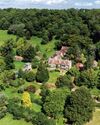A marvel revived

We cannot have beauty without paying for it.' So said George Leach Ashworth, the Mayor of Rochdale, at the opening of its new Town Hall on September 27, 1871. His words had a point, for the cost of the building had spiralled from an initial budget of $20,000 to the vast sum of $154,755. This had aroused great controversy, but the Mayor could claim in justification that the result was a masterpiece: Rochdale Town Hall is one of the most magnificent Victorian buildings in Britain. Now, its superb qualities may once again be appreciated fully, for the Town Hall has just emerged from a major renovation project at a cost of $20 million. In 2024-as in 1871 -the results amply justify the expense.
Today, the borough of Rochdale forms the north-eastern part of the metropolitan county of Greater Manchester. The landscape is undulating, rising to the moors to the north and east, and centred on the valley of the River Roch: hence the name. Rochdale originated as a large medieval parish embracing several hamlets, with the big church of St Chad at its heart. The area began to specialise in manufacturing woollen textiles and, when Celia Fiennes visited in about 1700, she found a 'pretty, neat town, all built of stone'. Cotton manufacturing arrived in the 1790s and, by the 1840s, the cotton mills rivalled the woollen mills, but the town's prosperity lay in the combination of the two. Rochdale was a Puritan town, with a radical, liberal tradition; it was also the birthplace of the Co-operative Movement in the 1840s.
Esta historia es de la edición April 10, 2024 de Country Life UK.
Comience su prueba gratuita de Magzter GOLD de 7 días para acceder a miles de historias premium seleccionadas y a más de 9,000 revistas y periódicos.
Ya eres suscriptor ? Conectar
Esta historia es de la edición April 10, 2024 de Country Life UK.
Comience su prueba gratuita de Magzter GOLD de 7 días para acceder a miles de historias premium seleccionadas y a más de 9,000 revistas y periódicos.
Ya eres suscriptor? Conectar

A brush with greatness
Victor Hugo found solace in art, but dismissed his drawings as mere things made 'during hours of almost unconscious reverie'. Now, a Royal Academy exhibition reveals how powerfully they engage the imagination

Havens and hideaways
Some houses offer that little bit extra– a garden building to enhance your quality of life

A night on the tiles
From bloody beginnings of drunken mayhem in public houses, it is somewhat surprising that the game of dominoes reached pearl-encrusted heights in our royal palaces

The legacy Gertrude Jekyll and herbaceous planting
Until Gertrude Jekyll showed us how to plant a flower border brimming with satisfying waves of colour, form and texture, no one had thought to do it.

Building on a dream
Evenley Wood Garden, Northamptonshire When Nicola Taylor took on her plantsman father's flower-filled woodland, she knew more about horses than trees, but, as Tiffany Daneff discovers, that hasn't stopped her from making a great success of the garden

Take a seat
What makes a chair supremely comfortable? The rake, the suspension system, the frame or the fillings

Sour to the people
Vibrant, tangy and full of flavour, malt vinegar is still the best British condiment to slosh over hot fish and chips

My favourite painting Sir James MacMillan
Le Christ en banlieue (Christ in the suburbs)

The architect for me
In the first of two articles, Clive Aslet explores the relationship between Sir Edwin Lutyens and perhaps his most important private client, the politician and financier Reginald McKenna

Directors take centre stage
The imaginative vision of those behind the scenes brings out the best acting in Shakespeare and Chekhov revivals
